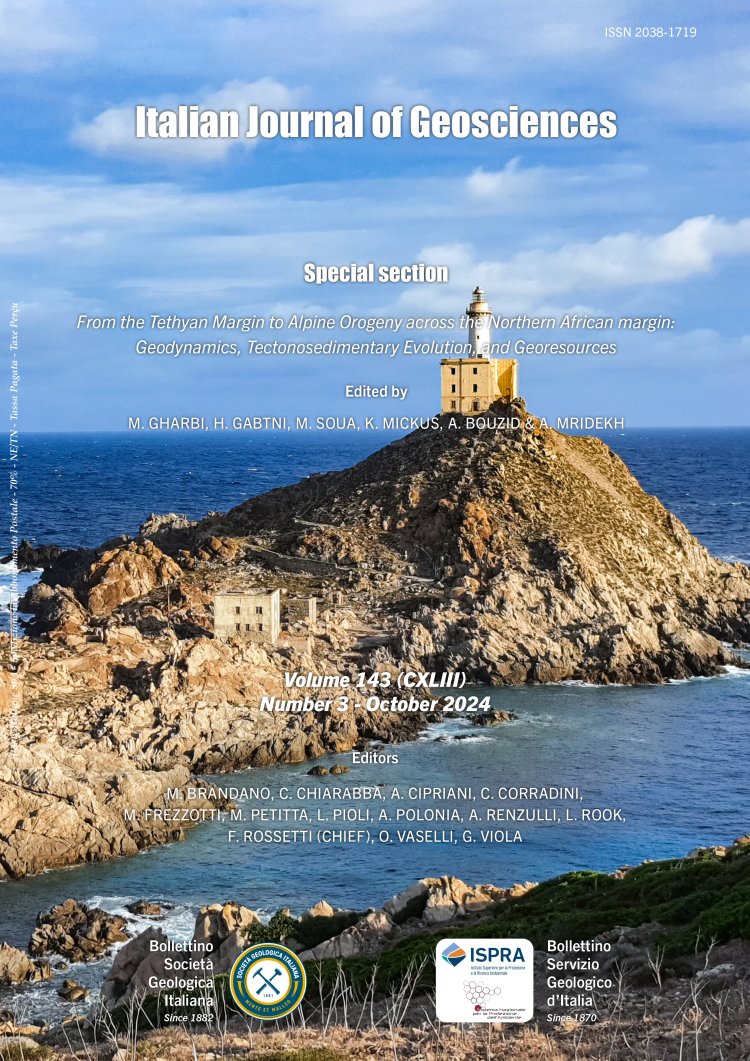
Role of the pre-orogenic rifting and preexisting Mesozoic salt tectonics on the deformation of the Southern Atlas front of Tunisia
Mohamed Gharbi1, David Boote2, Hamdi Mouakhar3, Hakim Gabtni1, Fabien Graveleau4 & Mohamed Soua5
1Water Research and Technologies Center, Geo-Resources Laboratory, Borj-Cedria, Soliman, Tunisia.
212 Elsynge Road, London, SW18 2HN.
3Entreprise Tunisienne d’Activités Pétrolières (ETAP), Tunis, Tunisia.
4Univ. Lille, CNRS, Univ. Littoral Côte d’Opale, UMR 8187-LOG-Laboratoire d’Océanologie et de Géosciences, Lille, France.
5Faculty of Sciences of Tunis, Tunis El Manar University, Tunisia.
Corresponding author e-mail: mohamed.gharbi@certe.rnrt.tn
Volume: 143 (2024) f.3
Pages: 345-364
Abstract
Hercynian crustal consolidation of Laurussia and Western Gondwana in the late Carboniferous was immediately followed by several Permian–Early Cretaceous rift events along the southern Tethyan continental margin of northwest Africa. The inherited extensional architecture later imparted a first-order control on the style of compressional shortening throughout the late Eocene, Late Miocene, and Pleistocene orogenesis. In this article, the role of structural inheritance during orogenic shortening has been assessed in the southeastern part of the Tunisian Atlas fold-thrust belt by synthesizing all available structural and geophysical data (surface geology maps and well, seismic and gravity data) in a 62-km-long balanced and sequentially restored cross-section across Jebel Bouhedma to Sebkhet En Naoual, Menzel El Habib and Jebel Itama in the south. The restored section highlighted a salt-cored thrusted sequence beneath Jebel Bouhedma anticline marked by a positive gravity anomaly. This developed as a salt diapir during the Mesozoic and was later deformed by thin-skinned thrusting during Cenozoic orogenesis. Basement rises to the south beneath the Sebkhat En Naoual-Menzel Habib plain and Jebel Itama where the Paleozoic-Mesozoic section is displaced by several thick-skinned reverse faults bounding north-tilted blocks. Cross-fault stratal geometries suggest these first developed as listric extensional faults during the Permian-Mesozoic and were reactivated later in response to Cenozoic compression. Sequential restoration of the balanced section highlighted the importance of (i) pre-orogenic Mesozoic faults and salt structures in localizing the later compressional deformation of the Bouhedma thrust anticline; and (ii) earlier extensional faults that controlled the position of later thick-skinned thrusts. The balanced cross-section suggests this part of the South Atlas Province experienced up to 5.4 km (8.6%) orogenic shortening, achieved by reactivation of basement normal faults and pre-orogenic diapiric salt structures formed during extensional rifting across the Southern Tethyan continental margin.
Keywords
diapiric salt, basement inheritance, reactivation, balanced cross-section, gravity modeling, Tethyan passive margin.
Get Full Text